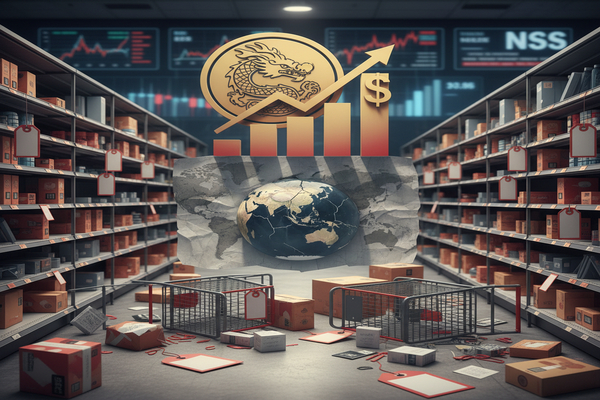
Trump’s 100% China tariff threat rattles retailers. The U.S. president said he could double tariffs on Chinese imports to 100 percent, driving fears of higher consumer prices and weaker demand now. In the short term, retailers face margin compression and inventory re-pricing. Over the long term, companies could rearrange sourcing, investment and supply chains. The move matters across regions: U.S. consumers may pay more, European suppliers could face spillovers, Asian exporters would feel direct pain and emerging markets risk slower trade growth. The announcement echoes past tariff rounds that raised prices and tested corporate resilience.
Immediate consumer and retail impact
Retailers warned that a sudden jump to 100 percent tariffs on Chinese goods would push costs sharply higher. Price tags already reflect past tariff waves, and another doubling would add new layers of expense. That will squeeze margins for companies that cannot pass costs fully to shoppers. It could also sap demand as households delay purchases or trade down to cheaper alternatives. Retail sales are a central signal for economic activity. A pronounced hit to consumption would affect quarterly revenue prints and inventory strategies.
Analysts and trade experts point out that some costs are already being absorbed by U.S. firms. That means immediate profit margins may fall before consumer prices fully adjust. The news has prompted retailers to reconsider sourcing plans and procurement timing. If tariffs are enacted quickly, companies may accelerate orders to lock in current input costs. If implementation is delayed, firms may wait to see whether policy changes hold.
Market reaction and corporate moves
Financial markets reacted to the rhetoric. Wall Street futures climbed after a brief cooling of the president’s tone, indicating markets are sensitive to language and policy risk. Volatility typically rises when trade policy threatens core profit pools for large segments of the economy. Firms that rely heavily on imported goods from China have the most to lose.
Large financial firms are adjusting strategy in a higher-policy-risk world. JPMorgan (NYSE:JPM) is one of the global banks shifting capital to sectors tied to national security and domestic resilience. Reports show it plans to invest up to $10 billion in U.S. companies that it views as critical to national security. That move signals a broader corporate pivot toward domestic investment that could offset some trade tensions but will not erase immediate price effects for consumers.
At the same time, investment banks are reshaping teams as deal activity slows. Goldman Sachs (NYSE:GS) has faced leadership churn and departures among senior bankers after a pause in dealmaking. Lower deal volumes weaken fee pools and could further temper market enthusiasm for risk assets if trade concerns persist.
Supply chain knock-on effects across sectors
Supply chains will feel the ripple effects. Airlines, for example, face a reported $11 billion supply chain hit in 2025 from a range of disruptions and cost pressures. Higher tariffs on electronics and components would raise airline procurement costs indirectly by increasing input prices for equipment manufacturers. The cumulative effect raises operating expenses for many industries.
Telecom and network infrastructure deals could become more contentious. Italy is reported to be in a standoff with KKR (NYSE:KKR) over a telecom network, showing how strategic infrastructure can become politicized when foreign capital and national security collide. Trade policy that targets imports can also sharpen scrutiny of inbound investment and complicate cross-border deals.
Asia’s manufacturing hubs would be directly affected. Samsung Electronics (KRX:005930) is highlighted for strong profit prospects in technology thanks to AI-driven demand and higher chip prices. Even so, firms like Samsung operate integrated global supply chains. Broad tariffs on Chinese goods could force component suppliers and contract manufacturers to reroute production or absorb cost shocks, adding uncertainty to corporate profit forecasts.
Broader economic and market implications
Economists see a mixed picture for growth. Some forecasts point to stronger U.S. growth even as jobs gains remain weak and inflation proves sticky. Trade barriers can boost certain domestic producers in the near term if they capture market share from imports. However, the broader effect is usually higher consumer prices and lower global trade volumes. Emerging markets that depend on export-led growth could suffer if demand softens in major markets.
Historically, tariff escalations have tended to raise uncertainty and slow investment. Companies delay capital expenditure when policy risk is high. That is already visible in pockets of dealmaking and hiring decisions. Markets may recalibrate valuations as analysts adjust earnings assumptions for higher input costs and slower sales growth in affected sectors.
Meanwhile, central banks and policymakers will watch inflation data closely. If tariffs feed through into consumer prices, inflation could stay elevated, complicating monetary policy choices. The interplay between fiscal trade policy and monetary responses will be a key theme for investors watching economic data and central bank commentary in the weeks ahead.
Scenarios for businesses and investors
Companies are weighing practical responses. Some will accelerate near-term orders to avoid higher tariffs. Others will seek alternative suppliers outside China or invest in reshoring where feasible. These moves take time and capex, and they do not remove near-term cost pressure.
For markets, the immediate outcome is likely to be higher volatility in sectors most exposed to imports. Technology, retail and consumer discretionary names could be the most directly affected. At the same time, defensive sectors that rely less on imports may see relative stability. Policymakers and companies will both monitor legal and trade channels for mitigation options, including exemptions and tariff reviews.
The timing of any tariff implementation and potential political shifts will matter a great deal. Market participants will track official announcements, corporate commentary on guidance and order flows, and inflation readings to reassess risks. For now, traders and managers are pricing in an elevated degree of policy uncertainty and rebalancing exposures accordingly.
Overall, the threat of 100 percent tariffs on Chinese imports has moved beyond rhetoric. It is now a potential driver of near-term price pressure and strategic corporate responses that could alter sourcing and investment patterns globally. How businesses adjust and how quickly policymakers act will shape economic outcomes in the months ahead.












